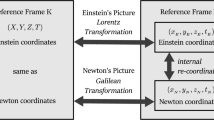Summary
Light speed invariance and nonconservation of simultaneity of separate events are often considered as peculiar properties of Einstein's special relativity (SR). On the contrary it is possible to formulate SR so that simultaneity be conserved and light speed be no longer invariant.Vice versa it is possible to formulate prerelativistic, or Galilean physics (GP), so that simultaneity be no longer conserved and light speed be invariant. Simultaneity conservation (or not) and light speed invariance in both GP and SR depend on the arbitrary way in which the clocks of reference systems are synchronized. This arbitrariness leads to infinite possible coordinate transformations (T) in GP, the simplest and most convenient of which are the GalileanT. Similarly there are infinite possibleT in SR and the LorentzT is one of the two most convenient ones. The other suitableT is that of Ives-Tangherlini which implies absolute simultaneity and a noninvariant speed of light. This allows a revival of the ether, although no longer considered as a classical fluid, but as the electromagnetic field radiated by all particles of the universe. This ether should produce the slowing down of clock rate and longitudinal shortening of the moving rods which are the peculiar properties of SR.
Riassunto
L'invarianza della velocità della luce e la non conservazione della simultaneità di eventi separati sono spesso considerati come proprietà peculiari della relatività speciale (SR) di Einstein. Al contrario è possibile formulare la SR in modo che la simultaneità sia conservata e la velocità della luce non risulti invariante; viceversa è possibile formulare nella fisica Galileana (GP) una teoria prerelativistica che non conservi la simultaneità e nella quale la velocità della luce risulti invariante; dimostreremo infatti che, tanto nella GP quanto nella SR, la conservazione o meno della simultaneità e dell'invarianza della velocità della luce dipendono dal modo, arbitrario, con cui si sincronizzano gli orologi dei sistemi di riferimento. Da tale arbitrarietà derivano, in GP, infinite possibili trasformazioni (T) delle coordinate di cui le più semplici e convenienti sono le trasformazioni galileane; similmente sono infinite le possibiliT di coordinate in SR di cui le lorenziane sono fra le più convenienti, oltre le più conosciute. Un'altra notevoleT è quella di Ives-Tangherlini caratterizzata dalla simultaneità assoluta e dalla varianza della velocità della luce.
Резюме
Инвариантность скорости света и несохранеие одновременности разделенных событий часто рассматриваются как характерные свойства специальной теории относительности Эинштеина. Напротив, можно сформулировать специальную теорию относительности так, что одновременность сохраняется, а скорость света не является инвариантом. И наоборот, можно сформулировать дорелятивистскую ияи галилееву физику так, что одновременность не сохраняется, а скорость света является инвариантом. Сохранение одновременности (или нет) и инвариантность скорости света в галилеевой физике и в специальной теории относительности зависят от произвольного способа, с помощью поторого синхронизируются часы в системах отсчета. Эта произвольность приводит к бесконечному числы возможных преобразований координат в галилеевой физике, наиболее простыми и удобными преобразованиями являются преобразования Галилея. Аналогично, существует бесконечное число возможных преобразований в специальной теории относительности, преобразования Поренца являются однимииз двух наиболее удобных. Другое удобное преобразование представляет преобразование Ивса-Тангерлини, которое подразумевает абсолютную одновременность и неинвариантность скорости света. Это преобразование приводит к возрождению эфира, который уже не рассматривается как классическая жидкость, а как электромагнитное поле, излучаемое всеми частицами вселенной. Этот эфир вызывает замедление хода часов и продольное укорочение движущихся стержней, которые представляют характерные свойства спецальной теории относительности.
Similar content being viewed by others
References
The first researcher to have considered a particular synchronization different from Einstein's was.H. B. Ives:J. Opt. Soc. Am.,27, 263 (1937). This same synchronization was rediscovered and further discussed byF. R. Tangherlini:Suppl. Nuovo Cimento,20, 1 (1961), who was unaware of the Ives work.
The first author to have considered the possibility of different possible synchronizations wasH. Reichenbach:The Philosophy of Space and Time, (Dover, New York, N.Y., 1958), followed byB. Ellis andP. Bowman:Philos. Sci.,34, 116 (1967), byYn. B. Mølchanov:Time in Classical and Relativistic Physics (Zuame, Moscow, 1969). However the complete understanding of the infinite possible synchronizations with a However the complete understanding of the infinite possible synchronizations with a noticeable impact on the world of the relativity experts occurred in 1977 by three important papers byR. Mansouri andR. V. Sexl:Gen. Relativ. Gravit.,8, 497, 515, 809 (1977). Successive developments on this line are due toM. Podlaha:Indian J. Theor. Phys.,26, 189 (1978), toT. S. Sjödin:Nuoco Cimento B,51, 229 (1979) and to ref. (6)G. Cavalleri andG. Spinelli:Phys. Found.,13, 1221 (1983).
For example one can use a rod, initially parallel to thex- andx′-axes, give it a velocity parallel to they-axis and synchronize the clocks when the rod crosses the axesx andx′. However one has to decide whether the accelerations along they′-axis of the two ends of the rod are simultaneous for eitherS orS′ or for neither of them.
See, for instance,R. Becker:Electromagnetic Fields and Interactions, Electromagnetic Theory and Relativity (P. C. Blaisdell, New York, N.Y., 1964), sect. 74, vol. 1, p. 312;W. H. Panofsky andM. Philipps:Classical Electricity and Magnetism (Addison Wesley, Reading, Mass., 1955), subsect. 14·4, p. 237;C. Møller:The Theory of Relativity (Clarendon press, Oxford, 1972), subsect 1·7, p. 24;M. A. Tonnellat:Les Principes, de la Theorie Electromagnetique et de la Relativité (Masson et Cie., Paris, 1959), subsect. 5·6, p. 106;J. P. Barrat:Electromagnetisme et Relativité Restreinte (Ediscience, Paris, 1972), subsect. 6·4c, pp. 223–224;J. H. Smith:Introduction to Special Relativity (Benjamin Inc., New York, N.Y., 1965), subsect. 2·7, p. 29;J. L. Anderson:Principles of Relativity Physics (Academic Press, New York, N.Y., 1967), subsect. 6·1, p. 134;W. Rindler:Essential Relativity (Van Nostrand Reinbold Company, New York, N.Y., 1969), subsect. 1·3 p. 8;P. C. Biasdell:Electromagnetic Theory and Relativity (New York, N.Y., 1964), sect.74, p. 312;P. G. Bergmann:Introduction to the Theory of Relativity (Prentice-Hall. Inc. Englewood Cliffs, N.J., 1942), Chapter III, especially p. 27.
G. Cavalleri, L. Galgani, G. Spavieri andG. Spinelli:Scientia,111, 667 (1976).
G. Cavalleri andG. Spinelli:Phys. Found.,13, 1221 (1983).
For a simple derivation of the Einstein-Hopf formula using modern notations seeT. H. Boyer:Phys. Rev. D,11, 809 (1975).
For a review of the stochastic electrodynamic theory seeM. Surdin:Ann. Inst. Henri Poincaré,15, 203 (1971) andT. H. Boyer:Phys. Rev. D,11, 790 (1975). For more recent progress seeG. Cavalleri:Phys. Rev. D,23, 363 (1981);T. H. Boyer:Phys. Rev.,30, 1228 (1984);Phys. Rev. A,36, 5083 (1987) and references therein; see also ref. (10).H. E. Puthoff:Phys. Rev. D,35, 3266 (1987).
G. Cavalleri:Lett. Nuovo Cimento,43, 285 (1985);G. Cavalleri andG. Spavieri:Nuovo Cimento B,95, 194 (1986);J Maddox:Nature,325 (1987).
H. E. Puthoff:Phys. Rev. D,35, 3266 (1987).
G. Cavalleri andG. Spavieri:Nuovo Cimento A,101, 213 (1989).
A. Rueda andG. Cavalleri:Nuovo Cimento C,6, 239 (1983).
H. Erlichson:Am. J. Phys.,53, 53 (1985).
G. Spavieri:Phys. Rev. A,34, 1708 (1986).
Author information
Authors and Affiliations
Additional information
Перевебено ребакцией.
Rights and permissions
About this article
Cite this article
Cavalleri, G., Bernasconi, C. Invariance of light speed and nonconservation of simultaneity of separate events in prerelativistic physics andvice versa in special relativity. Nuov Cim B 104, 545–561 (1989). https://doi.org/10.1007/BF02726163
Received:
Published:
Issue Date:
DOI: https://doi.org/10.1007/BF02726163



